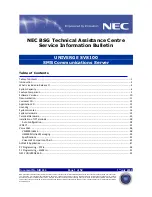
Ethernet Devices
Setting Up the ftServer System
5-27
Monitoring and Configuring Channel-Bonding Interfaces
By default, the physical Ethernet interfaces listed in
Table 5-2
are bound together into
two channel-bonding interfaces, called bond0 and bond1. The two channel-bonding
interfaces are set to operate in active-backup mode (mode 1) with Dynamic Host
Configuration Protocol (DHCP) enabled.
In many cases, no additional configuration is necessary. However, you may want to
change the default configuration to better meet your particular networking
requirements.
You configure and administer the Ethernet interfaces on your ftServer system just as
you would on any standard Linux system. Additionally, you can use the
ftsmaint
command to obtain information about the fault-tolerant status of the interfaces.
This section discusses the following topics:
•
‘‘
Monitoring Channel-Bonding Interfaces
”
•
‘‘
Configuring Channel-Bonding Interfaces
”
•
‘‘
Determining Interface Device Names
”
Monitoring Channel-Bonding Interfaces
You can monitor the fault-tolerant status of channel-bonding interfaces by using the
ftsmaint
command.
Example 5-6
shows the default configuration of the embedded
Ethernet devices:
Example 5-6. Default Configuration of Embedded Ethernet Devices
#
/opt/ft/bin/ftsmaint lsVnd
Virtual Network Device (VND) Groups
===================================
Group Name Status Inet Address RX Errors TX Errors Collisions
---------------------------------------------------------------------
bond0 ONLINE 134.111.78.103 0 0 0
bond1 ONLINE 192.168.4.10 0 0 0
bond2 OFFLINE - 0 0 0
bond3 OFFLINE - 0 0 0
bond4 OFFLINE - 0 0 0
VND Group Members
=================
Member Group Name Status Interface Link State Link Speed
--------------------------------------------------------------------------
eth000010 bond0 DUPLEX UP - -
eth000011 bond1 DUPLEX UP - -
















































